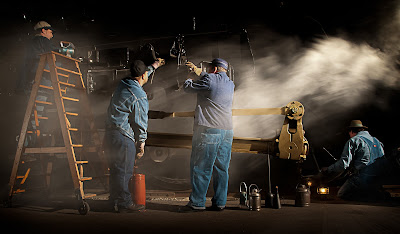 One of these days I'll get over my new interest in shooting trains, but I'm not sure when. Taking a raw (in several senses of the word), working it in Adobe Photoshop Lightroom 3 and going to Adobe Photoshop CS5 only to put it out for the web is, probably, the ideal way to treat a straight image. Photoshop is an amazing application, but 99% of what needs to be done to a straight image can be done in LR3. I'm going to have to play with the Export dialog box in Lightroom to see if it's as convenient as the Save For Web And Devices (in the File dropdown). My biggest issue is that LR3 doesn't give as much information as does CS5. In Lightroom you make the same basic decisions as is done in CS5, but there isn't a mechanism to see the effect of those decisions. The dialog box for the Save for Web and Devices in Photoshop (or Adobe Photoshop Elements 9) changes the other parameters depending on the change you make. Let's say you have a full size image (no cropping) and bring it into Save for W&D. It'll show you the dimensions in pixels, and probably tell you it exceeds what's typical. If you plan on entering it any competitions you probably want to have the horizontal size no more than 1024 pixels and the vertical size no more than 768. In CS5 you can see that changing the governing dimension changes the file size. If it doesn't fit the file size requirement, it can be adjusted using the numerical Quality number. Quality is given with a physical number, not just a slider. You can watch the file size go down as the Quality is lowered. In Lightroom, you can make all the same changes. You just can't tell what the effect of your decisions are. Something has to "float", and not knowing what's floating can lead to strange things happening. To find out about the non-strange things happening in today's image, hit the "read more".
One of these days I'll get over my new interest in shooting trains, but I'm not sure when. Taking a raw (in several senses of the word), working it in Adobe Photoshop Lightroom 3 and going to Adobe Photoshop CS5 only to put it out for the web is, probably, the ideal way to treat a straight image. Photoshop is an amazing application, but 99% of what needs to be done to a straight image can be done in LR3. I'm going to have to play with the Export dialog box in Lightroom to see if it's as convenient as the Save For Web And Devices (in the File dropdown). My biggest issue is that LR3 doesn't give as much information as does CS5. In Lightroom you make the same basic decisions as is done in CS5, but there isn't a mechanism to see the effect of those decisions. The dialog box for the Save for Web and Devices in Photoshop (or Adobe Photoshop Elements 9) changes the other parameters depending on the change you make. Let's say you have a full size image (no cropping) and bring it into Save for W&D. It'll show you the dimensions in pixels, and probably tell you it exceeds what's typical. If you plan on entering it any competitions you probably want to have the horizontal size no more than 1024 pixels and the vertical size no more than 768. In CS5 you can see that changing the governing dimension changes the file size. If it doesn't fit the file size requirement, it can be adjusted using the numerical Quality number. Quality is given with a physical number, not just a slider. You can watch the file size go down as the Quality is lowered. In Lightroom, you can make all the same changes. You just can't tell what the effect of your decisions are. Something has to "float", and not knowing what's floating can lead to strange things happening. To find out about the non-strange things happening in today's image, hit the "read more".There's actually quite a bit of detail work done to today's image. The primary focus is the fellow dead center in the shot. He took the brunt of the light and the back of his jacket and pants were pretty blown out. Some delicate use of the adjustment brush and careful lowering of the Exposure and Brightness values brought the clothing to a more normal (less extreme???) exposure differential.
The face and hair of the fellow second from the left had to be brought down in a similar manner. If I have to work on more the one area with the same basic technique I'll still drop individual pins and treat each area separately. The reasoning behind this decision (even if the numerical value of the particular adjustments are the same) is to give total flexibility. If bringing two different areas down together you'll have to remember that you're not just making that one adjustment. Later in the process, because of other changes) you might need to change the value of one area and not the other (or one more than the other). Keeping the options open is a great asset as you head toward the finish of an image.
Several other areas got their own pins also. Places like the glove of the guy in the middle of the image. The lantern, the face of the fellow on the right (lightened), the train itself and others. By the time I finish with an image it can have as many (most ever by me) as thirty or more pins, designating individual adjustments.
Lightroom 3 is for more than just broad sweeps of changes. The Adjustment Brush goes down to the single (or couple) pixels range for a reason. Parts of the lantern were "trimmed" with a two or three pixel brush. Can you see what was done? Probably not unless I point it out to you. That's what makes the difference between a nice image and a saleable image. Always ask yourself if you'd pay money to have that print. If the answer is yes, you're done.





0 comments:
Post a Comment